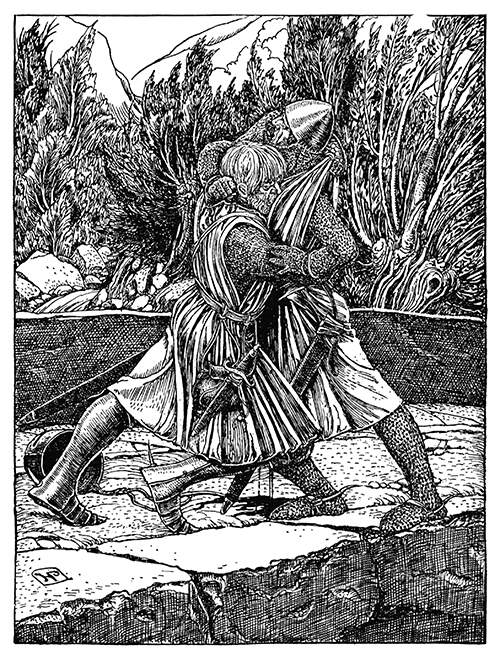I enjoy using Hits, their simple and effective lending themselves well to decisive combat with clear stakes. Generally I give player characters 4-6 hits (depending on the degree of grittiness) and have 2-3 hits as the "base damage" from blades and simple weapons or so such.
Hits are an ongoing event, not a thing you Have. It's an abstraction to tell you what sort of effect to expect. It's more about showing the effect violence will have, rather than an individuals resistance to it.
Conversely you can treat hits more traditionally, as dramatic points of saving grace, if you were so inclined. I would argue however, it is easy to give a bit more cinema to fight simply by upping the number of hits (as Skorne does) while keeping their impact. A more horror-violence approach, would use less and place more cost onto actions. To do something will cost something, to do nothing will cost more.
***
The
"I pick, you choose method"* where one side declares their intent and the
opposite decides whether to let it succeed or take exchange damage.
With the small margins that Hits give a player
this becomes a very attractive bargain. And vice versa for npcs, monsters, and so
forth.
Riffing
off this we come to more general dilemmas, "suffer hits" becomes an
easy mechanisms of imposing costs onto choices. I personally mix it up between pick and choose and entirely player facing costs.
Example :
Margot
is brawling with a guard. She has the option to take 2 hits, while
giving none, but ensuring the opponent is pinned down and takes it;
wrestling the guard to the floor despite his slashing knife...
Example :
While dueling a pig-man, Lot is charged and given the option of taking 3 hits, or getting bowled over the parapet edge onto a nearby roof, and out of the fight. Lot chooses his own skin over blocking the walkway and takes the tumble...

Don't think of fights happening in discrete segments, like a turn-based video game's trade of blows, actions flow into and from one another; momentum and weight matter. The previous positioning informs further actions and positioning.
Example :
The
dragon slams Jorge into the ground, knocking the wind from him and
crushing ribs (-3 hits), he drives his sword into the wyrm's leg as it pushes
down, and the wound makes the dragon recoil (-2 hits),dangling Jorge in the air as he holds onto his sword...
Alternatively
fights can be abstracted out, hits taken can be elaborated into broader
pushes and retreats or the tallied results of a dust-cloud obscured brawl. Likewise time can be stretched and contracted as needed.
Example :
Pent
and their hirelings held the line against the grub-dog onslaught
suffering 2 hits each in the process, while Maureen cut her way to the
capstan, taking 1 hit, and released it, dropping the gate closed...
Note also how in the previous example a numerically superior enemy is treated more as an environmental hazard than as discrete individuals. 'Blobification' of monsters and npcs (friendly or hostile) is a useful tool. For visual reference consider Kurosawa film where large groups move as one, and repeat emotions and movements for larger impact.
When running proper blob on blob violence; that is, unit skirmishes; said 'blobs' or detachments, to steal a turn of phrase from Into the Odd, can be assigned with stats as an individual. Maneuvers for units should be broader and more basic, retreats, pushes, and holds mainly. Consider morale heavily, when units break (at 0 hits perhaps), and so forth. A handy way of handling large scale fights is to treat them as series of decisive clashes, punctuated by retreats, regrouping, and repositioning.
Example :
Holland holds the road with his spear armed villagers against the mercenaries, the two groups collide and the villagers fall back having suffered a whopping 4 hits, but held firm thanks to Holland's exhortations. They retreat behind the nearby stonewall, and Calliope's villagers ambush the pursuing mercenaries, bloodying their noses (-1 hit) and sending them back onto the road...
Individuals in mass combat, unless targeted, can come out suffering a lesser form of whatever was inflicted on the detachment. So an individual fighting in a shattered unit might come out with musket ball through the leg and bleeding from a head wound. But a character fighting with a lightly scuffed unit may come out perfectly hale.
Hits should renew frequently with rest, in fact it may be best to have
them automatically renew any time there is an interval between fights.
Rely instead on injuries and effects to have lasting consequence and
inform future conflicts. A grievous leg injury, for example, would effect a fight.
This is of course suited for a grittier aesthetic approach.
Oh this is bloody lovely
ReplyDeleteThis is good food for thought. I like the idea of using hits to play out bigger thematic pieces of the "environmental / giant creature" fight. Well done!
ReplyDelete